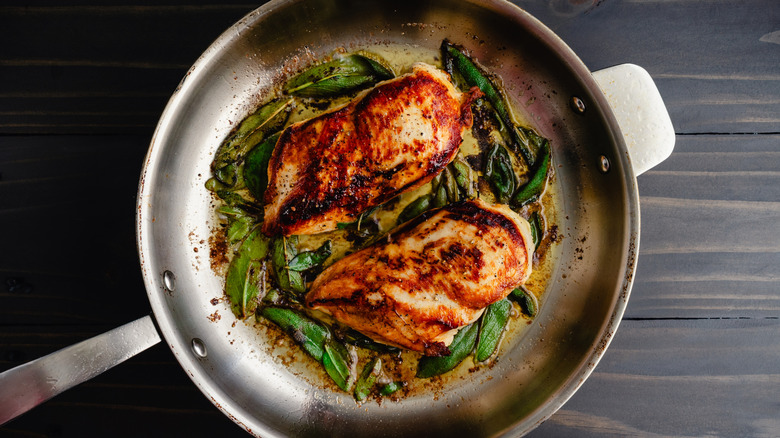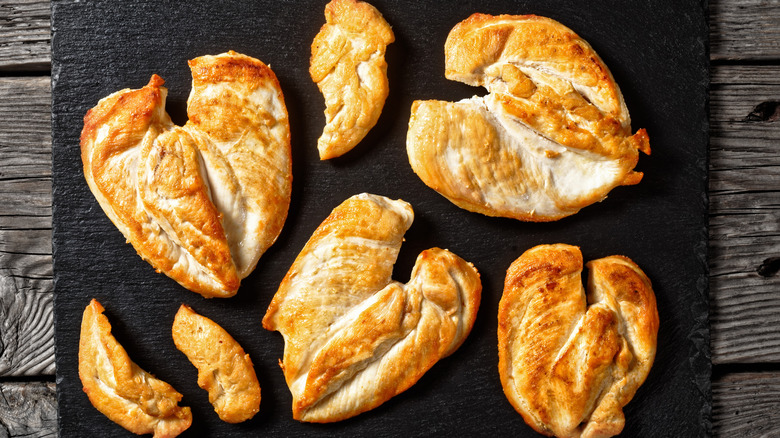The 3-2-1 Chicken Rule That Delivers The Juiciest Breasts Every Time
When it comes to quick and satisfying weeknight meals, few dishes rival the humble chicken breast. Endlessly versatile and packed with protein, they're a great option paired with a delicious marinade for everyday meals, as part of your weekly meal prep, and are even a great dish for post-workout and recovery. They can also be dressed up, like a chicken piccata with a Negroni or a French chicken suprême. While they come with many advantages, there are a few drawbacks. Compared to their juicier counterpart — the chicken thigh — breasts are much leaner and lower in fat. While this might be appealing to some, this also means that they can lose moisture very easily when cooked over high heat, which can turn them dry and rubbery. To uncover the perfect formula for consistently cooking flavorful, juicy chicken breasts, Food Republic consulted Chef Thomas Odermatt of Butcher's Bone Broth, who revealed that the 3-2-1 rule delivers the juiciest results every time.
"The 3-2-1 rule is like a beautiful classical concert. It is like rhythm -– quick sear, gentle finish, tiny pause," Odermatt explained. "It's short, it's simple[,] and it works every time." Similarly to how the 3-2-1 method is used for Passover brisket, the numbers correspond to timing. In the case of chicken breasts, the units are minutes rather than hours: a three-minute sear, a two-minute steam, and a one-minute rest. So by sticking to this precise rhythm using a timer, you can achieve perfectly tender, flavorful chicken breasts every time.
The 3-2-1 rule in action
The most important rule of the 3-2-1 method is the three-minute sear. "A quick, hot sear on each side locks in flavor and builds that golden crust ideally using a cast iron pan that you can heat up to the [extreme]," Thomas Odermatt told us."This isn't just color — it's the Maillard reaction, where natural proteins and sugars transform into delicious new flavor compounds." A stainless steel pan also works well for its ability to retain heat and promote even browning. For a good sear, aim for a medium-high heat. If your pan is too hot, your chicken may stick to the pan. Sear the chicken on each side, using a thermometer to ensure safety (aim for a minimum of 165 degrees Fahrenheit). While three minutes each side is a reliable guideline, cooking time depends on factors such as thickness or density. As a rule of thumb, this method works best for thin, butterflied chicken breasts.
The second step calls for turning off the heat. "I often shut down the gas, cover the pan, and let the chicken rest in its own steam," Odermatt explained. By creating a humid environment, the steam gently finishes cooking the chicken without harsh direct heat, retaining moisture and flavor that gets lost during pan frying, according to Odermatt.
The final step is letting the chicken rest undisturbed off the heat, which "allows the juices to settle back into the meat," Odermatt told us. This crucial but often overlooked step should be applied to all cooked chicken as it allows the muscle fibers, which tighten during cooking, to relax and reabsorb their flavorful juices, resulting in a juicier, tender cut of chicken. "Cut too soon, and the goodness runs out onto your plate," Odermatt warned.


